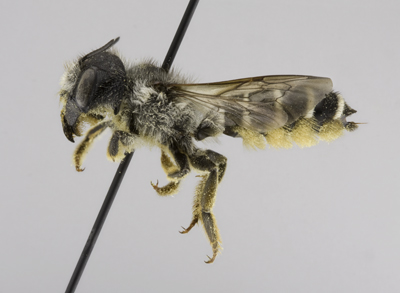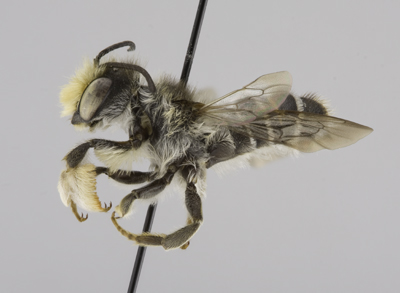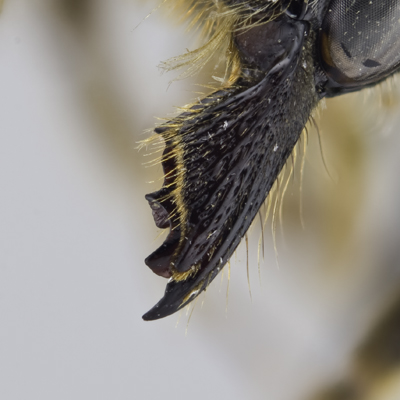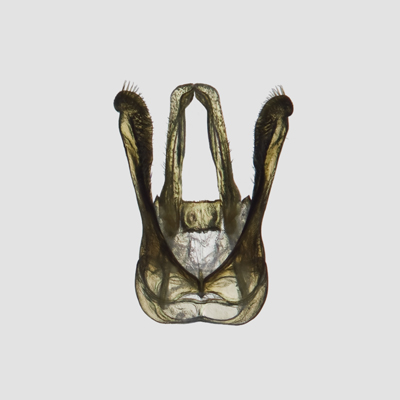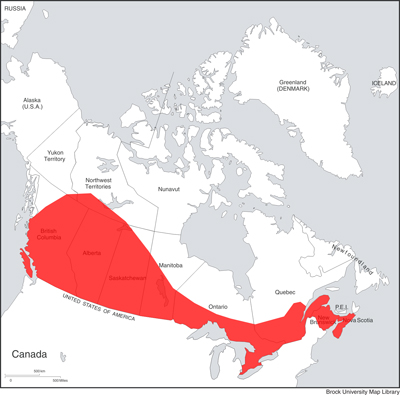
29. Megachile (Sayapis) pugnata Say, 1837
Megachile pugnata Female |
Megachile pugnata Male |
Megachile pugnata Say, 1837. Boston Jour. Nat. Hist. 1: 408 (♂, ♀).
Megachile scrobiculata Smith, 1853. Cat. Hym. Brit. Mus. 1: 191 (♂).
Megachile bucephala Smith, 1853. Cat. Hym. Brit. Mus. 1: 193 (♀).
Megachile disparilis Cresson, 1872. Trans. Amer. Entomol. Soc. 4: 264 (♂).
Megachile lucrosa Cresson, 1872. Trans. Amer. Entomol. Soc. 4: 267 (♀).
Gnathocera cephalica Provancher, 1882. Nat. Canad. 13: 233 (♀).
Megachile temporalis Friese, 1903. Ztschr. System. Hym. Dipt. 3: 247 (♀ only).
Megachile pugnata pomonae Cockerell, 1916. Ann. Mag. Nat. Hist (8) 17: 278 (♀).
Diagnosis.The female of M. pugnata is distinct and can be recognized by the prominent robust process on the lower edge of the gena. The male of Megachile pugnata can be recognized by the combination of 3-dentate mandibles, T5 with white apical fascia, front basitarsus with brush of short, dark bristles reduced, not extending beyond its basal third, and apical third of boat-shaped dilation entirely covered on the outer side with dense appressed hairs. They are most similar to M. fidelis and Megachile pugnata. Males of Megachile pugnata have T5 without white apical fascia, and the front basitarsus with boat-shaped dilation elongated apically and extending to apex of 3rd tarsomere. Males of M. fidelis have the front basitarsus with brush of dark bristles extending nearly to apex, with boat-shaped dilation mostly bare and polished in apical third.
FEMALE: Length 12-18 mm.
Head:
Figure M29: Megachile pugnata female mandible |
1) compound eyes slightly divergent below; lateral ocelli very much nearer eyes than margin of vertex (5:7), 2) clypeus extremely short and very much thickened apically, about as long or only slightly longer medially than the thickened apical edge, margin with a rather broad, median, truncate protuberance and a pair of more lateral tubercles, 3) mandibles very broad apically, obscurely 5-dentate, the 4th tooth very low and rounded, not acute like remaining teeth, with a small incomplete cutting edge between 2nd and 3rd teeth (Figure M29), 4) gena nearly twice the width of compound eye (8:5), with a conspicuous, flattened, subtriangular process opposite lower end of eye, 5) vertex rather dull, punctures very fine and close, becoming relatively coarse and more separated on gena above, larger and more irregular below, lower surface of gena apical to process broadly shining and impunctate; frons densely rugosopunctate, conspicuously protuberant between antennae, punctures of supraclypeal area quite coarse and distinct but very close, with a small impunctate area along apical edge; clypeus with very fine, densely crowded punctures medially, becoming coarse and more distinct laterally, shiny and impunctate below margin, 6) pubescence white on face and gena, short but rather dense on paraocular area, more yellowish on clypeus and on lower surface of gena, very short and sparse on gena above, vertex with quite conspicuous, erect, black pubescence that does not hide surface, 7) F1 quadrate, subequal in length to pedicel and F2, remaining flagellomeres slightly longer than broad (3:2), apical flagellomere more elongate (4:2.5).
Mesosoma:
1) pubescence rather short, quite dense, white laterally and posteriorly, pubescence of mesoscutum largely black, sparse and erect, becoming pale across anterior margin, scutellum with somewhat more elongate, black hairs, with a few paler hairs toward posterior margin, 2) mesoscutum finely and closely punctate, punctures slightly separated only in centre, those of scutellum and axilla uniformly very fine and close; pleura dull, very closely punctate, more coarsely so below and finer above; propodeum somewhat smoother but dull and quite densely pubescent, punctures close but minute and vague, triangle dull and impunctate, 3) all basitarsi somewhat shorter and narrower than their tibiae, apical segments of legs somewhat reddish-brown, 4) tegula almost impunctate, a few minute and rather close punctures anteriorly, 5) wings subhyaline basally, becoming somewhat infuscated apically, veins brownish-black.
Metasoma:
1) elongate and parallel-sided, T2-T4 more or less deeply grooved across base, less so on T5, basal margin of grooves carinate, apical margin of terga rather deeply depressed, with dense, entire, whitish fasciae; pubescence of T1 whitish, rather copious and elongate, becoming dense at sides, with some shorter, more apical, brown hairs; discal pubescence T2-T6 very short, erect and quite dense, entirely black; punctures of terga very fine and close throughout; apical margin of T6 rather abruptly upturned, rather narrowly rounded, surface very densely and finely punctate, pubescence suberect and entirely black, 2) S6 subtriangular, with narrow slightly emarginated apex, S6 uniformly covered with short, blackish scopal hairs; scopa otherwise pale yellow, the more basal sterna finely and closely punctate, punctures becoming more coarse and sparse on the more apical sterna, apical margins somewhat depressed, distinctly yellowish-hyaline.
MALE: Length 11-13 mm.
Head:
1) compound eyes subparallel; lateral ocelli subequally distant from eyes and margin of vertex, 2) clypeal margin beneath pubescence nearly straight, with very shallow, median and sublateral emarginate areas, 3) mandibles quite slender, 3-dentate, lower process triangularly acute, covered with white pubescence, submedian in position, 4) gena wider than compound eye (9:7), with a shining, impunctate, concave area ventrally, its lower margin forming a conspicuous and rather slender process just below base of mandible, 5) vertex and gena rather dull, punctures very fine and densely crowded, face dull, densely and finely rugosopunctate beneath dense pubescence, 6) face with copious, erect, yellowish-white pubescence largely obscurring surface below level of ocelli, gena with white pubescence, rather short above, becoming dense and elongate below, vertex sparsely pubescent with erect and elongate brownish hairs, yellowish at lateral margin, 7) F1 slightly broader than long (2:1.5), longer than pedicel, and shorter than F2, which is slightly longer than broad (2.5:2), remaining flagellomeres longer than broad (3:2), apical flagellomere very slightly dilated, more elongate (4.5:2).
Mesosoma:
1) pubescence white, rather short and dense laterally and posteriorly, mesoscutum with quite copious, erect and elongate brownish hairs, becoming whitish anteriorly, scutellum with whitish pubescence, 2) punctures of mesoscutum fine and close, slightly separated only in centre, densely crowded otherwise, those of scutellum and axilla uniformly fine and slightly separated; pleura dull, punctures rather shallow but very close, becoming densely crowded above; propodeum somewhat smoother, punctures shallow, very fine and close, triangle rather dull, impunctate, 3) front coxal spine very slender and elongate, anterior surface of coxa bare and somewhat shining, with a patch of 4 or 5 elongate, reddish bristles just before base of spine; mid tibial spur well developed; front tarsus bright yellow, basitarsus enormously expanded anteriorly and apically, very deeply excavated, inner basal margin of excavation with a short fringe of brown hairs not extending beyond its basal third, the hairs otherwise entirely pale yellowish, the basitarsal scale extending fully to tip of tarsomere 2, the more posterior part of tarsomere 2 much shorter than that of 1 and 3, posterior fringe pale yellow, quite dense and elongate, more or less brownish beneath; outer surface of front tibia and posterior surface of front femur black, other surfaces more or less yellowish-brown; mid and hind basitarsi slender and simple, largely dark, the more apical tarsomeres becoming more yellowish-brown, spurs yellow, 4) tegula yellowish-brown, shining, impunctate except in anterior half, 5) wings subhyaline, veins brownish.
Metasoma:
1) T2-T5 rather shallowly depressed across base, their basal margin distinct and carinate, T4 with a dense basal fascia of appressed yellow hairs arising from below the carinate lip (this often hidden under apical margin of T3); apical margin narrowly depressed on the more basal segments, becoming quite broad, more or less yellowish-hyaline and narrowly white fasciate, fasciae quite dense and conspicuous on T4 and T5; T1, and T2 basomedially with copious, elongate, pale pubescence, but T2 also with some shorter, more apical, brownish pubescence, discal pubescence of T3 and T4 short, erect, quite copious and entirely black, that on T5 largely black, but more erect and elongate; punctures of terga very fine and close throughout; dorsal surface of T6 vertical, very densely and finely rugosopunctate, carina rather short but distinct, with small, more or less rounded, median emargination, median teeth of apical margin very low, carinate, much closer to lateral angles than to each other, but these lateral angles not at all spinose; T7 rather robust, obscurely angulate medially, but not produced, 2) S1-S4 exposed, rather dull but very minutely and regularly punctate, punctures quite close but not crowded, apical margin depressed and yellowish-hyaline, that of S4 very slightly incurved across median area, apical margins with long pale hairs, though hardly forming fasciae, discal pubescence sparse and pale, not obscuring surface.
Genitalia: Figure G29.
|
Figure G29: Megachile pugnata genitalia |
Discussion:
This common species is one of the most distinct and easily recognizable Megachile in Canada. It accepts trap nests (Medler 1964; Sheffield et al. 2008) (Table 1). Tepedino and Frohlich (1982) and Frohlich and Parker (1983) detail much of its biology. It is a floral specialist on Helianthus and has shown much promise as a manageable pollinator of sunflower (Tepedino and Frohlich 1982; Parker and Frohlich 1983). Divergence levels in CO1 (2.66%) suggest that the southwestern form of this species (M. pugnata pomonae) may be a distinct species, though further study is required.
Distribution:
This is the most widespread member of the subgenus Sayapis; it occurs in southern Canada from NS-BC, extending north to southern NT and YT (see Map 29).
|
Map 29: Canadian distribution of Megachile pugnata |
